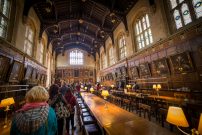The Affirmative Action of the Future
We’ve seen some peculiar developments as the Supreme Court gets closer to deciding the fate of affirmative action practices in higher education. Prominent law and medical schools withdrew from the U.S. News College Rankings. Columbia University became the first Ivy League school to drop SAT/ACT requirements, permanently. Many have speculated that these strategies are meant to continue racially discriminatory admissions policies in a post-affirmative action era. But there is no need for speculation: this is all by design.
In 2019, the College Board published a brazenly titled “playbook” which contains strategies for universities to continue racial discrimination through facially race-neutral approaches in admissions and beyond. The idea is for universities to pursue and achieve diversity-related goals without triggering legal scrutiny. In other words, the three “plays” highlighted in this book aim to engrain racially discriminatory policies in university enrollment practices.
Without the existence of such a playbook, those opposed to these strategies would be left to make unconvincing “disparate impact” arguments as to their discriminatory effects. This style of anti-discrimination enforcement has led to extraordinary government overreach because it assumes intent to discriminate when any racial disparity is observed. However, since the playbook makes clear that the goal of these strategies is racial diversity of the student body, it is clear that the universities that adopt them are intending to discriminate.
Some may note that most of these policies are not intended to discriminate against certain groups, such as Asians, but rather intended to help other groups, such as Blacks. However, the courts make no such distinction between “benign” and “invidious” discrimination when they consider cases under Title VI of the Civil Rights Act. This is the correct approach: the plain language of the law supports a color-blind interpretation. We should not have double standards for enforcing anti-discrimination rules on behalf of some groups but not others. This is why it is crucial to force federally-funded universities to take a color-blind approach to their admissions; anything short of it will bring racial discrimination through the back door.
The first play is for universities to adopt more flexible admissions policies. In practice, this often means dropping standardized testing requirements. The College Board might appear as if it is working against its own interests since it administers the SATs. But the organization is actively securing its own future by lobbying states to require the SATs for all high school juniors. Test-optional universities will still need to find ways to measure applicant quality when they relinquish objective metrics of academic preparedness. They typically rely more on “holistic” criteria, which consider factors such as a student’s extracurricular activities and character traits.
Subjectivity in admissions criteria clears pathways for racial discrimination, among other types of prejudice. In the 1920s, Harvard used holistic admissions practices to intentionally slash the Jewish student population from 27% to 15%. Modern affirmative action policies revived the use of discriminatory criteria in holistic admissions. An analysis presented during the 2018 Supreme Court hearings on affirmative action showed that Harvard systematically gave Asian American applicants lower scores on traits like “positive personality,” “likability,” and being “widely respected.” History demonstrates the possible channels of discrimination through lax admissions policies. The presence of such a recommendation in the College Board’s playbook is alarming and leaves wide pathways to practice racial discrimination with no accountability.
As universities make increasingly radical changes to their admissions policies to prepare for a post-affirmative action world, those who believe in fairness and merit should prepare too.
The second strategy is to increase “race attentive” outreach and recruitment. The College Board notes that anti-discrimination law treats recruitment strategies more leniently than admissions. Therefore, colleges can shift their racial discrimination to outreach and recruitment initiatives and avoid legal scrutiny, even if affirmative action becomes illegal. These activities expand the number of minorities universities consider during the admissions process, which the universities hope will increase their racial diversity.
These strategic recruitment practices extend far beyond general undergraduate admissions. In fact, they are much more effective when deployed in smaller programs, where small changes in the applicant pool can have a major effect. The University of North Carolina’s journalism school serves as an illustrative example. It offers a small media diversity preparatory program for high school seniors. The discriminatory nature of the program appears to be common knowledge, as even the one white male stated that his acceptance was “pretty ironic,” though he was “more than happy to be the token white guy.”
Even without explicit racial discrimination on the part of the selection committees, these programs can still produce discriminatory effects. The majority of white, and possibly Asian, students who see the term “diversity,” will likely avoid applying to such programs because they’ve been told repeatedly that they are the wrong kind of “diversity.” Limited information plays a part as well: universities decrease the competition as they usually target their marketing to specific school districts, which limits the knowledge about these programs.
The second play becomes more potent with universities dropping testing requirements. Racial discrimination in outreach will have a downstream effect on enrollment as participation in these programs will weigh more heavily in admissions. Removing objective criteria, furthermore, allows universities to skew the applicant pool to match desired characteristics. Universities now have a greater chance to choose students who meet their racial diversity metrics.
The third strategy encourages universities to add an “experience or service commitment associated with race” to their admissions and scholarship criteria. The College Board highlights the University of Florida’s McQuown Scholarship Program. Through interviews and essays, Florida administrators evaluate the applicant’s commitment to include racial minorities or women in various activities, ability to overcome barriers (including socioeconomic), and dedication to community service. Administrators use broad language to make it appear as though any student has the chance to earn scholarships. But the context of the playbook makes it clear that these service experiences are being used as proxies for race. The College Board tries to claim plausible deniability by stating that such strategies should employ “authentic” recruitment of all races.
This third strategy has other deleterious downstream effects. Much like diversity statements in faculty hiring, these service commitments reinforce viewpoint discrimination on campus. Students will be selected based on their ideological commitments, rather than on their academic merit. Even students who are, nonetheless, generous with their time and talents in a color-blind way will be excluded.
As universities make increasingly radical changes to their admissions policies to prepare for a post-affirmative action world, those who believe in fairness and merit can prepare too. Boards of trustees can denounce these practices and commit to keeping objective metrics of academic merit in their admissions policies, such as those at CalTech. State lawmakers can expand their fight against diversity statements in faculty hiring to student admissions, and ensure that any essay or extracurricular requirements are color-blind in nature. Civil rights authorities can investigate any university that drops objective admissions criteria in the wake of legal challenges to affirmative action.
Ending affirmative action would be a victory for fairness in American higher education. But the fight will not stop there. Universities should be eager to develop the potential of all students. Until university administrators give up on their racial diversity goals, we will need to remain vigilant.



